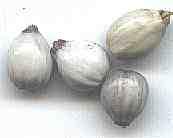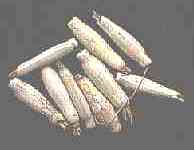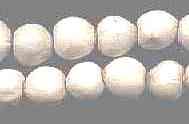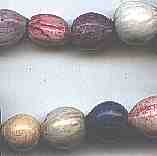Principal path =Home>Beadmaking & Materials>Organic Materials> Job's Tears
The Most Worn Bead Plant
|
Job's Tears were once an important source of food. Botanists disagree over its place of origin. The great, N.I. Vavilov (a victim of the psuedoscience that dominated Stalin's USSR) placed its origin in the Greater Sundas. These are the four largest islands of Indonesia (Borneo, Sumatra, Java and Sulawesi, formerly the Celebes). Anglo-Indian botanists believe it originated in northeast India.
In either case, it was domesticated very early for food. Maybe even before rice. In the wild, the fruit has a hard, shiny coat. After domestication, this coat becomes less hard and easier to cook into a porridge. It ranks --- along with wheat and barley in the Near East; beans, corn, squash and pepper in the Americans; and rice in Asia -- as one of the earliest domesticated plants.
What makes this plant so important to the bead world is that the fruit is perfect for stringing. It is one of the rare natural beads in either the plant or animal kingdoms.
At its tip is a hole that allows the flower to emerge. When picked off the stem, the rounded end breaks off, leaving a hole. The inside is so soft that it is easily pierced
Hence, an instant bead.
|
How long have Job's Tears been used for beads? We will probably never know. One was found in Timor (one of the smaller Indonesian islands) dating to about 3000 B.C. It was reported as a "bead," but there is no other evidence to support this idea.
However, from a recently excavated site in western India comes indisputable proof that Job's Tears were used as beads around 2000 B.C. A beadmaking shop was uncovered, where the workers were crafting beads from steatite (soapstone). Within the shop were many Job's Tears, apparently to be strung up with the steatite beads.
At a southern Indian archaeological site dated to the first century or so, a wire was excavated with five Job's Tears strung on it. Job's Tears are common finds in south Indian sites. Archaeologists were calling them "rice beads," because the plant grows wild in rice fields. Now they know what they are.
Today Job's Tears are everywhere. The plant has been introduced to many countries, where it is used as a food supplement (you can buy it in health food stores in the US). I recently ran across a photo of myself taken in New York City in 1968 or 1969. I was wearing a triple strand of colored Job's Tears. (I wonder where it is now.)
|
__________________________________________________
Small Bead Businesses | Beading & Beadwork | Ancient Beads | Trade Beads
Beadmaking & Materials | Bead Uses | Researching Beads | Beads and People
Center for Bead Research | Book Store | Free Store | Bead Bazaar
Shopping Mall | The Bead Auction | Galleries | People | Events
The Bead Site Home | Chat Line | Contact Us | Site Search Engine | FAQ



